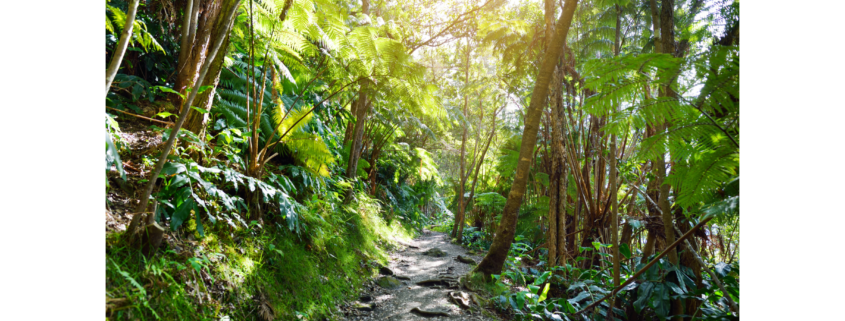The Best Hikes around Volcanoes National Park
Volcanoes National Park on the Big Island of Hawaii is an amazing destination known for its dynamic volcanic landscapes, lush rainforests, and stunning views. Whether you are an avid hiker seeking challenging trails or a casual explorer looking for a leisurely walk, the park offers a variety of hikes to suit all levels of fitness and experience. Even if you’re staying in Kona, a day trip to Volcanoes National Park is a must. With its dramatic scenery and unique geological features, a trip to this park is a highlight of any Hawaiian adventure. Here are some of the best hikes in Volcanoes National Park, categorized by difficulty.
Easy Hikes
1. Kilauea Iki Trail
Kilauea Iki Trail offers a relatively easy and highly rewarding hiking experience. The trail is approximately 4 miles round trip and typically takes around 2-3 hours to complete. Starting at the Kilauea Iki Overlook, the trail descends through a lush rainforest before reaching the crater floor. Here, you can walk across a solidified lava lake that was once a boiling cauldron of molten lava during the 1959 eruption. Steam vents and fascinating rock formations make this hike both educational and visually stunning.
2. Sulphur Banks Trail (Ha‘akulamanu)
For a gentle and informative hike, the Sulphur Banks Trail is ideal. This 1.2-mile round trip hike offers an easy walk with a fascinating look at the park’s volcanic activity. The trail includes a boardwalk section that is wheelchair accessible through a forest where you can observe steaming vents and colorful mineral deposits. Interpretive signs along the way provide insight into the geothermal processes and the unique ecology of the area. The combination of vibrant colors and geothermal phenomena makes this a must-see for any visitor.
Moderate Hikes
3. Devastation Trail
Devastation Trail offers a moderate hike through an otherworldly landscape shaped by volcanic activity. This 1-mile round trip trail is relatively short but provides a profound experience as you walk through an area that was buried by cinders during the 1959 eruption of Kilauea Iki. The stark contrast between the barren landscape and the regenerating forest is striking. Along the trail, you’ll find interpretive signs that explain the eruption’s impact and the area’s gradual recovery. This trail is fully accessible and features a paved path suitable for wheelchairs and strollers.
4. Thurston Lava Tube (Nāhuku)
The Thurston Lava Tube trail combines a moderate hike with a fascinating geological wonder. The trail is about 1.5 miles round trip and takes you through a lush rainforest to the entrance of a large, naturally formed lava tube. Walking through this tunnel, you’ll get a sense of the power of volcanic activity that shaped the island. The lava tube is illuminated for easy navigation, making it a family-friendly hike with a unique twist.
Challenging Hikes
5. Pu‘u ‘Ō‘ō Trail
For those seeking a more challenging adventure, the Pu‘u ‘Ō‘ō Trail is a fantastic option. This trail is approximately 8 miles round trip and traverses varied kīpuka, areas of old-growth forest spared between lava flows, including forested areas, open lava fields, and volcanic craters. The trail leads to the site of the 1983 eruption, where you can see the effects of the lava flows and enjoy panoramic views of the volcanic landscape. The hike is strenuous due to the uneven terrain and exposure to the elements, but the breathtaking scenery and the sense of walking on recently formed land make it a truly rewarding experience. The trailhead is not technically in the park.

Coming from either direction on the Saddle Road, Hwy. 200, find yellow traffic signs marked with “Puu Oo Trail” (in both directions) between the 22 and 23 mile markers. Pull off the road and park in the small gravel lot. (Big Island Hikes)
6. Mauna Ulu
Another challenging hike that offers an unparalleled volcanic experience is the Mauna Ulu trail. This 8-mile round trip hike leads to the summit of Mauna Ulu, an active volcanic vent. The trail passes through lava fields, with views of fissures, craters, and old lava flows. The landscape is surreal, with hardened lava formations and sparse vegetation. The climb to the summit is strenuous, but the reward is a spectacular view of the surrounding area, including Pu‘u ‘Ō‘ō and the East Rift Zone. This hike provides a profound sense of the raw power and beauty of Hawaii’s volcanic landscape.
Tips for Hiking in Volcanoes National Park
- Prepare for Changing Weather: The weather in Volcanoes National Park can be unpredictable. Be prepared for rain, sun, and cooler temperatures, especially at higher elevations.
- Wear Appropriate Footwear: Trails can be rocky and uneven. Sturdy hiking shoes or boots are recommended.
- Bring Water and Snacks: Stay hydrated and energized, especially on longer hikes.
- Stay on Marked Trails: For your safety and to protect the fragile environment, always stay on marked trails.
- Respect Wildlife and Plants: The park is home to unique flora and fauna. Observe wildlife from a distance and do not pick plants or disturb the natural landscape.
Volcanoes National Park offers an extraordinary opportunity to explore Hawaii’s volcanic heritage. Whether you’re looking for an easy stroll, a moderate hike, or a challenging adventure, the park’s trails provide unforgettable experiences. Even from Kona, a day trip to Volcanoes National Park is well worth the journey, offering some of the best hiking opportunities in the world.
Looking for a place to stay? Check out what we have available for your dates.











